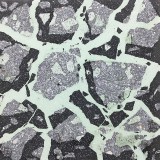The object of the research I attempt in this issue is the classification of matter in parallel with the art of mosaic. By analyzing the terminology surrounding these concepts and placing them in a logical order, I am led to undo the term mosaic as a whole, and construct a more comprehensive and descriptive vocabulary. By studying the various mosaic techniques that appear in East Asia and Europe from the Chalcolithic period to the present day, I discover and focus on materials, their mixing and casting in order to help me carry out my experiments, and at the same time I try to understand how, together with the work of the craftsman, led to their decline and replacement by other materials. Then, taking a few steps back, I focus on the "raw material" from which the tesserae and gravels are composed, i.e., the stone, trying to explain why it contains memory. Focusing my attention on specific categories of rocks, which are similar in substance to what we have until now called "mosaic", I discover the textures and the ways in which they are produced by nature. These rocks are called sedimentary and metamorphic. The art of the mosaic and the processes of the earth are then mixed together, through the mosaic called the man-made landscape, with relationships of sorting and recycling. Finally, using all the information I collected, and by finding materials in the fabric of the city, I construct experiments, which act as models to investigate the actions of nature and man. The repetition of the various stages involved in conducting the experiments, and the constant contact with matter and the dusting of the hands, end up giving this process a ritualistic character.
